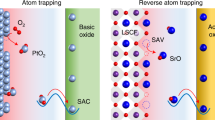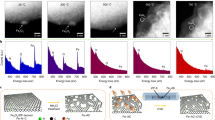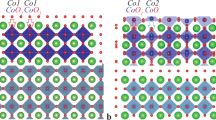Abstract
Point defects largely govern the electrochemical properties of oxides: at low defect concentrations, conductivity increases with concentration; however, at higher concentrations, defect–defect interactions start to dominate1,2. Thus, in searching for electrochemically active materials for fuel cell anodes, high defect concentration is generally avoided. Here we describe an oxide anode formed from lanthanum-substituted strontium titanate (La-SrTiO3) in which we control the oxygen stoichiometry in order to break down the extended defect intergrowth regions and create phases with considerable disordered oxygen defects. We substitute Ti in these phases with Ga and Mn to induce redox activity and allow more flexible coordination. The material demonstrates impressive fuel cell performance using wet hydrogen at 950 °C. It is also important for fuel cell technology to achieve efficient electrode operation with different hydrocarbon fuels3,4, although such fuels are more demanding than pure hydrogen. The best anode materials to date—Ni-YSZ (yttria-stabilized zirconia) cermets5—suffer some disadvantages related to low tolerance to sulphur6, carbon build-up when using hydrocarbon fuels7 (though device modifications and lower temperature operation can avoid this8,9) and volume instability on redox cycling. Our anode material is very active for methane oxidation at high temperatures, with open circuit voltages in excess of 1.2 V. The materials design concept that we use here could lead to devices that enable more-efficient energy extraction from fossil fuels and carbon-neutral fuels.
This is a preview of subscription content, access via your institution
Access options
Subscribe to this journal
Receive 51 print issues and online access
$199.00 per year
only $3.90 per issue
Buy this article
- Purchase on Springer Link
- Instant access to full article PDF
Prices may be subject to local taxes which are calculated during checkout




Similar content being viewed by others
References
Kilner, J. A. & Steele, B. C. H. The effect of ion size on the energy of association between oxygen vacancies and dopant cations in oxide solid electrolytes. J. Electrochem. Soc. 129, C143–C148 (1982)
Irvine, J. T. S., Feighery, A. J., Fagg, D. P. & García-Martín, S. Structural studies on the optimisation of fast oxide ion transport. Solid State Ionics 136/137, 879–885 (2000)
Atkinson, A. et al. Advanced anodes for high-temperature fuel cells. Nature Mater. 3, 17–27 (2004)
Primdahl, S., Hansen, J. R., Grahl-Madsen, L. & Larsen, P. H. Sr-doped LaCrO3 anode for solid oxide fuel cells. J. Electrochem. Soc. 148, A74–A81 (2001)
Singhal, S. C. & Kendall, K. High Temperature Solid Oxide Fuel Cells: Fundamentals, Design and Applications (Elsevier, Oxford, 2004)
Matsuzaki, Y. & Yasuda, I. The poisoning effect of sulfur-containing impurity gas on a SOFC anode: Part I. Dependence on temperature, time and impurity concentration. Solid State Ionics 132, 261–269 (2000)
Zhu, W. Z. & Deevi, S. C. A review on the status of anode materials for solid oxide fuel cells. Mater. Sci. Eng. A 362, 228–239 (2003)
Park, S., Vohs, J. M. & Gorte, R. J. Direct oxidation of hydrocarbons in a solid-oxide fuel cell. Nature 404, 265–267 (2000)
Perry, E., Tsai, T. & Barnett, S. A. A direct-methane fuel cell with a ceria-based anode. Nature 400, 649–651 (1999)
Tao, S. W. & Irvine, J. T. S. A redox-stable efficient anode for solid-oxide fuel cells. Nature Mater. 2, 320–323 (2003)
Canales-Vázquez, J., Tao, S. W. & Irvine, J. T. S. Electrical properties in La2Sr4Ti6O19-δ: a potential anode for high temperature fuel cells. Solid State Ionics 159, 159–165 (2003)
Marina, O. A., Canfield, N. L. & Stevenson, J. W. Thermal, electrical, and electrocatalytical properties of lanthanum-doped strontium titanate. Solid State Ionics 149, 21–28 (2002)
Mukundan, R., Brosha, E. L. & Garzon, F. H. Sulfur tolerant anodes for SOFCs. Electrochem. Solid-State Lett. 7, A4–A7 (2004)
Canales-Vázquez, J., Ruiz-Morales, J. C., Irvine, J. T. S. & Zhou, W. Sc-substituted oxygen excess titanates as fuel electrodes for SOFC. J. Electrochem. Soc. 152, 1458–1465 (2005)
Marina, O. A. & Pederson, L. R. in Proc. 5th European Solid Oxide Fuel Cell Forum (ed. Huijsmans, J.) 481–489 (European Fuel Cell Forum, Oberrohrdorf, Switzerland, 2002)
Canales-Vázquez, J., Smith, M. J., Irvine, J. T. S. & Zhou, W. Studies on the reorganisation of extended defects with increasing n in the perovskite-based La4Srn-4TinO3n+2 series. Adv. Funct. Mater. 15, 1000–1008 (2005)
Holtappels, P., Bradley, J. L., Irvine, J. T. S., Kaiser, A. & Mogensen, M. Electrochemical characterization of ceramic SOFC anodes. J. Electrochem. Soc. 148, A923–A929 (2001)
Irvine, J. T. S., et al. Optimisation of perovskite titanates and niobates as anode materials for SOFCs. in Proc. 4th European SOFC Forum (ed. McEvoy, A. J.) 471–477 (European Fuel Cell Forum, Oberrohrdorf, Switzerland, 2000)
Poeppelmeier, K. R., Leonowicz, M. E. & Longo, J. M. CaMnO2.5 and Ca2MnO3.5 — new oxygen-defect perovskite-type oxides. J. Solid State Chem. 44, 89–98 (1982)
McIntosh, S., Vohs, J. M. & Gorte, R. J. Effect of precious-metal dopants on SOFC anodes for direct utilization of hydrocarbons. Electrochem. Solid-State Lett. 6, A240–A243 (2003)
Liu, J. & Barnett, S. A. Operation of anode-supported solid oxide fuel cells on methane and natural gas. Solid State Ionics 158, 11–16 (2003)
Lin, Y., Zhan, Z., Liu, J. & Barnett, S. A. Direct operation of solid oxide fuel cell with methane fuel. Solid State Ionics 176, 1827–1835 (2005)
Ovalle, A., Ruiz-Morales, J. C., Canales-Vázquez, J., Marrero-López, D. & Irvine, J. T. S. Mn-substituted titanates as efficient anodes for direct methane SOFCs. Solid State Ionics (submitted).
Acknowledgements
This work was funded partly by a EU Marie Curie Fellowship and by EPSRC.
Author information
Authors and Affiliations
Corresponding author
Ethics declarations
Competing interests
Reprints and permissions information is available at npg.nature.com/reprintsandpermissions. The authors declare no competing financial interests.
Rights and permissions
About this article
Cite this article
Ruiz-Morales, J., Canales-Vázquez, J., Savaniu, C. et al. Disruption of extended defects in solid oxide fuel cell anodes for methane oxidation. Nature 439, 568–571 (2006). https://doi.org/10.1038/nature04438
Received:
Accepted:
Issue Date:
DOI: https://doi.org/10.1038/nature04438
This article is cited by
-
Recent progress in electrolyte-supported solid oxide fuel cells: a review
Journal of the Korean Ceramic Society (2023)
-
Urea electrooxidation: Research progress and application of supported nickel-based catalysts
Ionics (2023)
-
Effect of chromium doping on structural development and electrical properties of LaNiO3 perovskites
Journal of Electroceramics (2023)
-
Review of solid oxide fuel cell materials: cathode, anode, and electrolyte
Energy Transitions (2020)
-
Electrochemical properties of Sr-doped layered perovskite as a promising anode material for direct hydrocarbon SOFCs
Journal of the Korean Ceramic Society (2020)
Comments
By submitting a comment you agree to abide by our Terms and Community Guidelines. If you find something abusive or that does not comply with our terms or guidelines please flag it as inappropriate.



